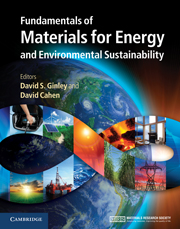Book contents
- Frontmatter
- Contents
- Contributors
- Preface
- Acknowledgments
- Part 1 Energy and the environment: the global landscape
- Part 2 Nonrenewable energy sources
- Part 3 Renewable energy sources
- Part 4 Transportation
- Part 5 Energy efficiency
- Part 6 Energy storage, high-penetration renewables, and grid stabilization
- 42 Toward the smart grid: the US as a case study
- 43 Consequences of high-penetration renewables
- 44 Electrochemical energy storage: batteries and capacitors
- 45 Mechanical energy storage: pumped hydro, CAES, flywheels
- 46 Fuel cells
- 47 Solar fuels
- 48 Solar thermal routes to fuel
- 49 Photoelectrochemistry and hybrid solar conversion
- Summary
- Appendix A Thermodynamics
- Appendix B Electrochemistry
- Appendix C Units
- Index
- References
42 - Toward the smart grid: the US as a case study
from Part 6 - Energy storage, high-penetration renewables, and grid stabilization
Published online by Cambridge University Press: 05 June 2012
- Frontmatter
- Contents
- Contributors
- Preface
- Acknowledgments
- Part 1 Energy and the environment: the global landscape
- Part 2 Nonrenewable energy sources
- Part 3 Renewable energy sources
- Part 4 Transportation
- Part 5 Energy efficiency
- Part 6 Energy storage, high-penetration renewables, and grid stabilization
- 42 Toward the smart grid: the US as a case study
- 43 Consequences of high-penetration renewables
- 44 Electrochemical energy storage: batteries and capacitors
- 45 Mechanical energy storage: pumped hydro, CAES, flywheels
- 46 Fuel cells
- 47 Solar fuels
- 48 Solar thermal routes to fuel
- 49 Photoelectrochemistry and hybrid solar conversion
- Summary
- Appendix A Thermodynamics
- Appendix B Electrochemistry
- Appendix C Units
- Index
- References
Summary
Focus
Electric power systems constitute the fundamental infrastructure of modern society. Electric power grids and distribution networks, often continental in scale, reach virtually every home, office, factory, and institution in developed countries and have made remarkable, albeit remarkably insufficient, penetration in developing countries such as China and India.
Synopsis
The electric power grid can be defined as the entire apparatus of wires and machines that connects the sources of electricity, namely the power plants, with customers and their myriad needs. Power plants convert a primary form of energy, such as the chemical energy stored in coal, the radiant energy in sunlight, the pressure of wind, or the energy stored at the core of uranium atoms, into electricity, which is no more than a temporary, flexible, and portable form of energy. It is important to remember that electricity is not a fuel: it is an energy carrier. At the end of the grid, at factories and homes, electricity is transformed back into useful forms of energy or activity, such as heat, light, torque for motors, or information processing.
- Type
- Chapter
- Information
- Publisher: Cambridge University PressPrint publication year: 2011



